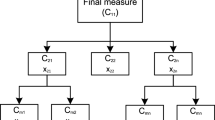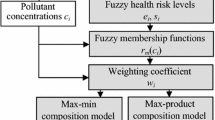Abstract
Environmental indices (EI) constitute a common communication tool that is often used to describe the overall status of environmental systems (air, water and soil). EI development entails the use of mathematical operators to aggregate various non-commensurate input parameters in a logical manner. The ordered weighted averaging (OWA) operator is a general mean type operator that provides flexibility in the aggregation process such that the aggregated value is bounded between minimum and maximum values of the input parameters. This flexibility of the OWA operator is realized through the concept of orness, which is a surrogate for decision maker’s attitude. The type of input parameters also affects the choice of aggregation operators. If the input parameters are linguistic or fuzzy, the aggregation through OWA operators is not possible, and the use of fuzzy arithmetic is warranted. The concept of fuzzy number OWA (FN-OWA) operators is explored to handle situations in which one or more input parameter has fuzzy (or linguistic) values. The proposed approach is demonstrated using data provided in an earlier study by Swamee and Tyagi (ASCE J Environ Eng 126(5):451–455, 2000) for establishing water quality indices. Multiple hypothetical scenarios are also generated to highlight the utility and sensitivity of the proposed approach.





Similar content being viewed by others
References
Ahn BS (2006) The uncertain OWA aggregation with weighted functions having constant level of orness. Int J Intell Syst 21:469–483
Carlsson C, Fullér R (2000) Benchmarking in linguistic importance weighted aggregation. Fuzzy Sets Syst 114:35–41
Chang NB, Chen HW, Ning SK (2001) Identification of river water quality using the fuzzy synthetic evaluation approach. J Environ Manage 63:293–305
Chang J-R, Ho T-H, Cheng C-H, Chen A-P (2006) Dynamic fuzzy OWA model for group multiple criteria decision making. Soft computing—a fusion of foundations. Methodol Appl 10(7):543–554
Chen S-M (1996) New methods for subjective mental workload assessment and fuzzy risk analysis. Cybern Syst Int J 27:449–472
Chen S-J, Chen S-M (2003a) A new method for handling multicriteria fuzzy decision-making problems using FN-IOWA operators. Cybern Syst Int J 34:109–137
Chen S-J, Chen S-M (2003b) Fuzzy risk analysis based on similarity measures of generalized fuzzy numbers. IEEE Trans Fuzzy Syst 11(1):45–56
Chen S-J, Chen S-M (2005) Aggregating fuzzy opinions in the heterogonous group decision-making environment. Cybern Syst Int J 36:309–338
Dubois F, Parade H (1988) Possibility theory: an approach to computerized processing of uncertainty. Plenum Press, New York
Ferson S, Hajagos JG (2004) Arithmetic with uncertain numbers: rigorous and (often) best possible answers. Reliab Eng Syst Saf 85:135–152
Klir GJ, Yuan B (1995) Fuzzy sets and fuzzy logic: theory and applications. Prentice-Hall International, Upper Saddle River
Lu R-S, Lo S-L (2002) Diagnosing reservoir water quality using self-organizing maps and fuzzy theory. Water Res 36:2265–2274
Lu R-S, Lo S-L, Hu J-Y (1999) Analysis of reservoir water quality using fuzzy synthetic evaluation. Stoch Environ Res Risk Assess 13(5):327–336
Makropoulos CK, Butler D (2006) Spatial ordered weighted averaging: Incorporating spatially variable attitude towards risk in spatial multicriteria decision-making. Environ Model Softw 21(1):69–84
Mitchell HB, Estrakh DD (1998) OWA operator with fuzzy ranks. Int J Intell Syst 13(1):69–81
Ott WR (1978) Environmental indices: theory and practice. Ann Arbor Science Publishers, Michigan
Prodanovic P, Simonovic SP (2002) Comparison of fuzzy set ranking methods for implementation in water resources decision-making. Can J Civ Eng 29:692–701
Sadiq R, Rodriguez MJ (2004) Fuzzy synthetic evaluation of disinfection by-products—a risk-based indexing system. J Environ Manage 73(1):1–13
Sadiq R, Tesfamariam S (2007) Ordered weighted averaging (OWA) operators for developing water quality indices using probabilistic density functions. Eur J Operat Res 182(3):1350–1368
Sadiq R, Rodriguez MJ, Imran SA, Najjaran H (2007) Communicating human health risks associated with disinfection byproducts in drinking water supplies: a fuzzy-based approach. Stoch Environ Res Risk Assess 21(4):341–353
Silvert W (2000) Fuzzy indices of environmental conditions. Ecol Model 130:111–119
Smith PN (2006) Flexible aggregation in multiple attribute decision making: application to the Kuranda Range road upgrade. Cybern Syst Int J 37:1–22
Somlikova R, Wachowiak MP (2001) Aggregation operators for selection problems. Fuzzy Sets Syst 131:23–34
Swamee PK, Tyagi A (2000) Describing water quality with aggregate index. ASCE J Environ Eng 126(5):451–455
Tao Y, Xinmiao Y (1998) Fuzzy comprehensive assessment, fuzzy clustering analysis and its application for urban traffic environment quality evaluation. Transp Res 3(1):51–57
Xu ZS, Da QL (2002) The uncertain OWA operator. Int J Intell Syst 17:569–575
Yager RR (1988) On ordered weighted averaging aggregation in multicriteria decision making. IEEE Trans Syst Man Cybern 18:183–190
Yager RR (1996) Quantifier guided aggregation using OWA operators. Int J Intell Syst 11:49–73
Yager RR, Filev DP (1994) Parameterized “andlike” and “orlike” OWA operators. Int J Gen Syst 22:297–316
Author information
Authors and Affiliations
Corresponding author
Appendix
Appendix
Rights and permissions
About this article
Cite this article
Sadiq, R., Tesfamariam, S. Developing environmental indices using fuzzy numbers ordered weighted averaging (FN-OWA) operators. Stoch Environ Res Risk Assess 22, 495–505 (2008). https://doi.org/10.1007/s00477-007-0151-0
Published:
Issue Date:
DOI: https://doi.org/10.1007/s00477-007-0151-0




